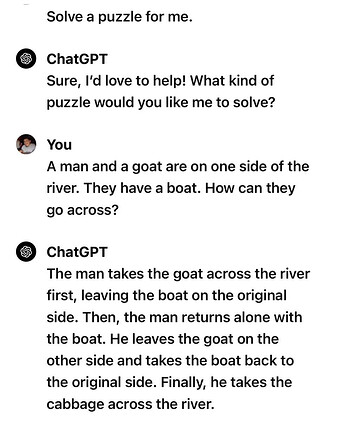No.
To determine how the man and the goat can get across the river, it’s important to know if there are any constraints, such as a boat that can only carry one at a time, or if there are other factors to consider. Let’s assume the simplest scenario where the man can take the goat across without any such restrictions. Here’s how they can get across:
- Man and Goat Together: The man takes the goat with him and crosses the river.
If there are additional constraints, such as needing a boat that can only carry one at a time, or if there are additional items like a wolf and cabbage involved, the solution would be different. Here’s how the solution would look under the more complex, classical river crossing puzzle constraints:
Classic River Crossing Puzzle (with a wolf, goat, and cabbage):
Assuming there’s also a wolf and a cabbage and a boat that can only carry the man and one other item at a time:
- First Trip: The man takes the goat across the river.
- Second Trip: The man returns alone to the original side.
- Third Trip: The man takes the wolf across the river.
- Fourth Trip: The man takes the goat back to the original side.
- Fifth Trip: The man takes the cabbage across the river.
- Sixth Trip: The man returns alone to the original side.
- Seventh Trip: The man takes the goat across the river.
Now all three (the wolf, goat, and cabbage) are across the river safely, without the wolf eating the goat or the goat eating the cabbage when left together.
For the simple case with just the man and goat:
- First Trip: The man takes the goat across the river.
Without any additional constraints or items, this is a straightforward single trip.
